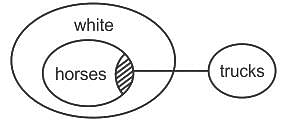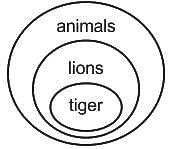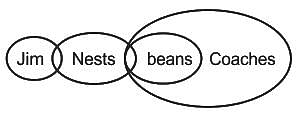Test: Syllogism - 1 - Mechanical Engineering MCQ
10 Questions MCQ Test General Aptitude for GATE - Test: Syllogism - 1
Two statements are given followed by two conclusions numbered I and II. Assuming the statements to be true, even if they seem to be at variance with commonly known facts, decide which of the conclusions logically follow(s) from the statements.
Statements:
Some horses are not trucks.
All horses are white.
Conclusions:
I. Some white are trucks.
II. Some horses being truck is a possibility.
Three statements are given followed by two conclusions numbered I and II. Assuming the statements to be true, even if they seem to be at variance with commonly known facts, decide which of the conclusions logically follow(s) from the statements.
Statements:
All birds are crows.
Some crows are parrots.
No crow is a pigeon.
Conclusions:
I. No parrot is a pigeon.
II. Some birds are parrots.
| 1 Crore+ students have signed up on EduRev. Have you? Download the App |
In the following question below are given some statements followed by some conclusions based on those statements. Taking the given statements to be true even if they seem to be at variance from commonly known facts. Read all the conclusions and then decide which of the given conclusion logically follows the given statements.
Statements:
I. No F is N.
II. All N are L.
Conclusions:
I. All F are L.
II. All N are F.
III. Some L are N.
Read the given statements and conclusions carefully. Assuming that the information given in the statements is true, even if it appears to be at variance with commonly known facts, decide which of the given conclusions logically follow(s) from the statements.
Statements:
All tigers are lions.
All lions are animals.
Conclusions:
Ⅰ. All tigers are animals.
Ⅱ. No tigers is a bird.
Read the given statements and conclusions carefully. Assuming that the information given in the statements is true, even if it appears to be at variance with commonly known facts, decide which of the given conclusions logically follow(s) from the statements.
Statements:
I. Some X are M.
II. All W are X.
Conclusions:
I. Some M are not W.
II. No W is M.
III. Some M are not X.
Read the given statements and conclusions carefully. Assuming that the information given in the statements is true, even if it appears to be at variance with commonly known facts, decide which of the given conclusions logically follow(s) from the statements.
Statements:
No plate is a spoon.
Some plates are forks.
All forks are knives.
Conclusions:
I. Some plates are knives is a possibility.
II. No spoon is a fork.
Read the given statements and conclusions carefully. Assuming that the information given in the statements is true, even if it appears to be at variance with commonly known facts, decide which of the given conclusions logically follow(s) from the statements.
Statements:
Some jugs are bottles.
No bottle is a candy.
All spoons are bottles.
Conclusions:
I. Some jugs are spoons.
Il. No spoon is a candy.
Ill. No jug is a spoon.
IV. No jug is a candy.
Read the given statements and conclusions carefully. Assuming that the information given in the statements is true, even if it appears to be at variance with commonly known facts, decide which of the given conclusions logically follow(s) from the statements.
Statements :
Some jims are nests.
Some nests are beams.
All beams are coaches.
Conclusions :
I. Some coaches are nests.
II. Some beams are jims.
III. No beam is a jim.
IV. Some nests are jims.
In the following question below are given some statements followed by some conclusions based on those statements. Taking the given statements to be true even if they seem to be at variance from commonly known facts. Read all the conclusions and then decide which of the given conclusion logically follows the given statements.
Statements:
I. All B are V.
II. All K are B.
Conclusion:
I. All K are V.
II. No V is B.
In the following question below are given some statements followed by some conclusions based on those statements Taking the given statements to be true even if they seem to be at variance from commonly known facts. Read all the conclusions and then decide which of the given conclusion logically follows the given statements.
Statements:
I. All Z are Y.
II. Some Y are B.
Conclusion:
I. Some B are not Z.
II. Some Y are not Z.
III. Some Z are Y.
|
198 videos|165 docs|152 tests
|
|
198 videos|165 docs|152 tests
|


























